How to Raise Chickens Naturally
Learning how to raise chickens begins with the pleasure of knowing that a meaningful relationship can be fostered with another living being alongside knowing where one's food comes from like meat or eggs. Having chickens around us offers us empathy into what life is like for another living being. They give us companionship, beauty and affection that we might not otherwise get were we to routinely buy eggs or cellophane wrapped chicken from the store. Whether it be weed or insect control or a more healthy or flavorful egg we're after let's take a closer look at ways to get started in chicken raising.
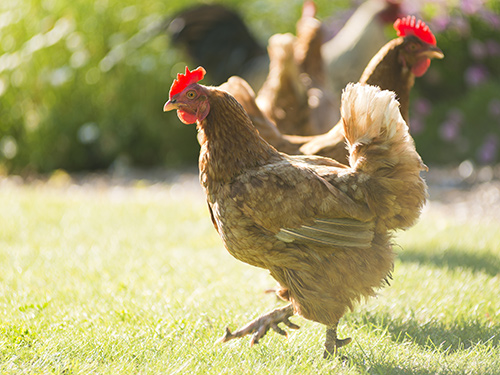
Choose your Chickens Wisely
As you learn how to raise chickens it's impossible to make decisions in isolation simply because there are so many considerations and like everything in nature, they are all connected. With this in mind, here are some things to consider when answering that big question of how to raise chickens:
- Rules and Regulations - There could be zoning laws for how to raise chickens whether you live "in town", "out of town" or even on the edge of town. There's often a variety of rules from how many chickens you can have to having them for show or breeding them. You can find out all this information from the county zoning department where you live. Remember that at the heart of it it's about relationships. It's important to be thoughtful of your neighbors and consider their needs, too. That's often why these laws exist. For example, you could select chickens that are on the quiet side so they're not a disturbance and also share eggs with neighbors to introduce your chickens to the neighborhood.
- Choosing a Breed - Determine whether you're choosing a breed of chicken for its feathers or for more practical purposes like for eggs, meat or both. Maybe you want a variety of breeds for an interesting visual experience. Chickens are grouped into different categories along these lines. Some breeds are better egg layers than others and some are great for meat. The Dual-purpose breeds (chickens that are good for both eggs and meat) are fantastic foragers, disease resilient and have vigorous health. It's helpful to know these different categories when you are in the planning process of how to raise chickens. Choose breeds that have tendencies to survive and thrive in your climate.
- Temperament and Personality - Some chickens are quite pushy, others are serene and still others are kind and loving. It all depends on the breed of chicken you're getting. While you can't completely determine the personality of every single chicken you'll get, there are patterns to the different breeds. Research what kind of dispositions different chickens have to them and choose breeds that you feel you'll be most compatible living with as you learn how to raise chickens.
- Time of Year - If you go with the way nature intended, it would make sense to get chicks in the springtime when the weather is warming up and new life is emerging. That said, you can actually get them any time of year. Remember to decide what stage you want to start at with the breed of chickens before you get started.
- Where to get a quality chicken - There are a variety of ways and places you can buy eggs to hatch, newly hatched chicks, young chickens or full grown chickens. Possibilities include a mail order catalog, a friend, a local store in town, or even the internet. Take into account the following factors when you get them:
- Where they came from and the environment they were hatched or living in.
- Their age and quality of health. Look for cleanliness of combs, eyes, nose, and mouth and any obvious health concerns like infections or parasites under their feathers, insects under their scaly legs, and the top and bottom of their beak lining up correctly.
- The cost for each chick or chicken including shipping and handling if ordered by mail.
- The size of your flock - Just like humans, chickens are social creatures so plan on getting at least a minimum of three chickens for your flock. As well, by getting a minimum of three you are keeping in mind that you might lose a chick from natural death or from the stress of transportation.
What stage to begin with - Decide what stage you want to start with raising chickens. Would you like to start out with chicks or full grown chickens? Getting chicks is usually monetarily cheaper than getting full grown birds depending on what breeds you get and where you buy them from. Chicks are also more of a guarantee you'll end up with chickens compared to hatching eggs. The chicks will get used to living with you right from the start and you will most likely learn a whole lot more about how to raise chickens if you start out with chicks.
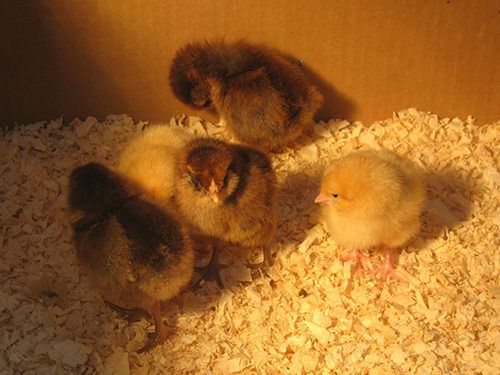
However some people love to experiment with and experience the process of the egg cracking open and witnessing that moment of life. One really isn't better than the other. It's more about what are you wanting and why. If you know this consciously up front and ahead of time you have a better opportunity for learning and discovering greater connection with your backyard chickens.
Combining your purpose with the needs of your chickens
It's important for you to consider your personal goals as you learn how to raise chickens and unite them with the needs of your chickens themselves. This will end up being simpler and more energy efficient so that you and your chickens will be happy not just now but in the future as well. This is where permaculture comes in handy. Permaculture is the development of regenerative agricultural ecosystems and other living systems. It is all about getting our needs met while giving back to the earth. There are many permaculture principles to help you achieve your goals, all the while tending to their needs, too. Let's take a look at one example you can use as a guide for synthesizing this symbiotic relationship.
The permaculture principles of not creating waste, storing energy, and designing from patterns informs the simple desire for fertilizing the ground to create a garden bed. Taking this into account you could use a chicken tractor to house your chickens.
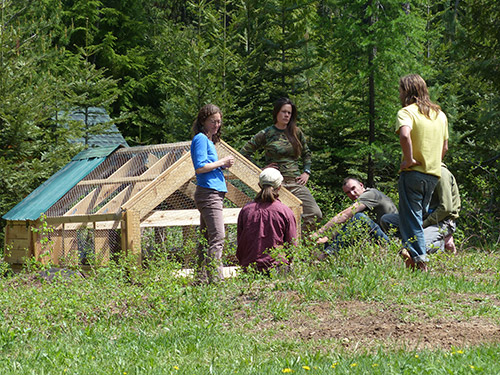
A chicken tractor is a mobile chicken coop without a floor. Chickens would scratch and turn the soil and in turn, the soil would be fertilized with chicken poop, thus adding richness to your future garden bed. This would then help you to grow food and produce a harvest more easily by using a small solution to the need for building up soil.
The needs of your chickens are important, too and permaculture recognizes this. Backyard chickens love fresh vegetation like grass, clover and other plants. They go after insects and worms with vigor and zeal. By using a chicken tractor you are rotating them to fresh places and they'll continually get fresh food and be healthy and happy.
There are a plethora of possibilities for how you can weave permaculture into the process of how to raise chickens. A great one is growing your own worms in a worm bin, feeding worms your compost, and then feeding some of the worms to your chickens. Another favorite of mine is gathering rainwater into a barrel and then channeling that water to your chickens for them to have water. In doing so you are creating a system that is doing the work that you would otherwise be doing yourself, and saving energy and valuable resources along the way.
If you are working with the elements of permaculture and allowing your chickens to intersect with your garden space you might want to let your garden plants mature before ushering your birds into the garden space. That way the plants are hardy enough to be nibbled on. Monitor your chickens rather than letting them roam without any observance of them.
Be mindful of planting poisonous plants that chickens shouldn't be browsing on, such as foxglove or any nightshade plants as you learn how to raise chickens. Consider planting hardy chicken resilient plants and/or plants that they would enjoy such as chickweed or chard. There are a many medicinal plants that both you and your chickens would benefit from such as dandelion, clover, plantain, and shepherd's purse. Lastly, consider planting large leafy or bushy plants such as Hosta that will noticeably soften chicken conversation. All of these are examples of thinking like a true permaculturist.
Shelter
Shelter is a crucial element in the process of learning how to raise chickens. In beginning your envisioning process of the shelter for your chickens, picture their housing as a refuge and retreat space that helps them thrive far beyond mere survival.
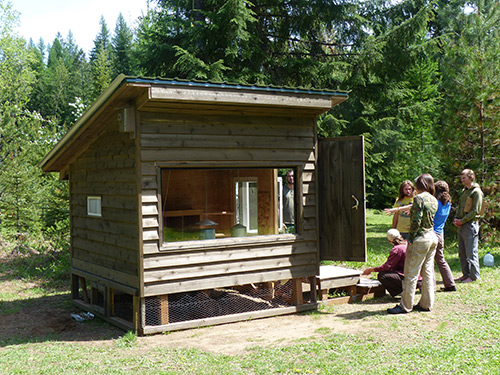
This then gives you the awesome opportunity to go beyond the idea that there is actually an "ultimate" shelter for your backyard chickens because there really isn't. Instead, there is the possibility for thoughtfully creating a dynamite shelter for your backyard chickens. Here are some key factors when making deliberate decisions about your coop:
- Size of flock - Determine the size of your flock before you go out and get a bunch of fluffy little chicks. They're small now but when they get bigger they'll need plenty of room outdoors for foraging and scratching in the dirt along with being indoors walking around and nesting. Different breeds of chickens are different sizes once they reach maturity. Some are fluffier than others. Plan on researching that and/or looking at pictures and specs of chickens to get a sense of how big or small they are. There are two main guidelines to remember when choosing the size of your flock:
- The size of your flock should take into account the amount of time, energy and resources you have to give them for a shelter
- The size of your flock should match the amount of space you have for your shelter
- Physical location - Location, location, location. A critical element to focus on as you discover how to raise chickens. Ideally, your chicken coop needs to be placed on level and well-drained soil and can handle withstanding a balance of sun, shade, wet and all the mixture of inclement weather patterns that may move through. With this in mind you need to ask yourself where would you like your chickens to forage? Would you like them to be fenced in and if so, where is the place that makes the best sense for you and your chickens needs? If you rotate your chickens from one spot to the next, what is the distance and amount of space for that rotation you can afford? You'll need some kind of roofing for them if you are rotating them around outside because chickens prefer staying dry. If you've decided on a portable shelter like a chicken tractor, is your shelter light weight and easy to move over a far distance if need be? If you've chosen a permanent shelter, how close to your home can you place it so you can keep an eye on them and visit them daily? This is the start of a variety of questions that need to be answered before you choose your location.
- Space for your chickens - Remember that you'll need a suitable amount of space for the size of your flock. Similar to humans, chickens cannot live in tight quarters and be healthy and happy. For example, a half dozen chickens need approximately 6 by 10 feet for a run so they can move about; stretch their legs, peck, scratch, and so on. If you are erring on the side of spaciousness it minimizes all sorts of issues that can come up with your chickens. Down the road you might end up getting more chickens and you'll be grateful for a larger coop rather than having to do a remodel or add on job later.
- Weather and environmental factors - Chickens are adaptable to different seasonal and weather conditions over time but different breeds are still intolerant to certain kinds of weather and have preferences for certain climates. Do research on which breeds are most suited to your climate and environment.
- Safety from predators - Here's where your connection with wildlife and birds becomes your ally as you discover how to raise chickens. With the knowledge and experience you have of animals and birds like foxes, hawks, and weasels that could prey on your chickens, you need to keep a close eye on them regularly. Even some pets can have predatory instincts. This could be as simple as watching for their tracks and sign around your chickens and the coop. From making traps to fencing to automatic door openers to flashy mylar strips or even to having a trusty canine around, there are a variety of ways to keep predators out. I have a door that opens and closes to prevent predators from getting in to my chickens' main housing area but still lets the chickens out to scratch in the dirt and make dust baths during the day light hours. Remember there are aerial predators that can get your chickens just as much as those slinking around like snakes and skunks. Your ultimate goal includes keeping predators out by eliminating all entry points for them to get in, thus keeping them away from your chickens. Make sure that your fencing is sturdy and that all latches close well on all doors of your coop. The ultimate tool you can use is the practice of your continual awareness keeping vigil over your chickens.
- Warmth and insulation - While a chicken can warm itself by moving around and by what it eats, you still need to support your chickens to be warm, especially in the winter months and/or if you live in a cold climate. Chickens can stop laying eggs if they are in extreme cold for too long and their toes and combs are susceptible to frostbite and can turn black or yellow. Our chicken coop is fully insulated so we don't need a heater in the winter months to keep them warm.
- Air circulation and light - Chicken coops need to be draft free, have good air flow, ventilation near the top and light or they tend to get musty, dry and dark. Our coop has a very large window facing south to maximize receiving the sun's warmth. My chickens rely on that light when there is less sunshine during the winter months. If your shelter is outdoors, then no worries, they'll be getting good air and light instantly. It takes a good two weeks of sunlight for the average chicken to produce an egg so you might even want to have an extra light for your chickens in the coop to balance out the gray days in the winter months.
- Access to shade - While a chicken is able to cool down by shifting some amount of their heat to their external environment, you'll still need to provide shade for them in the summertime when it's hot. They aren't able to completely cool down by themselves. This could be achieved by building an outdoor roof or as simple as giving them space under trees or around bushes or even pinning fabric over some fencing.
Available Resources - This is a really important point to consider as you learn about how to raise chickens. How much do you personally want and are able to invest in raising chickens? What resources do you have? Do you have the time, energy and skills to build a shelter for them yourself or do you only want to learn how to raise chickens in and of itself? Do you want to buy a pre-made chicken coop and if so, how much time and money are you willing to spend to find one that works for you and your chickens? I've spoken with various people who have been through a few coops in order to find the one that works for them.
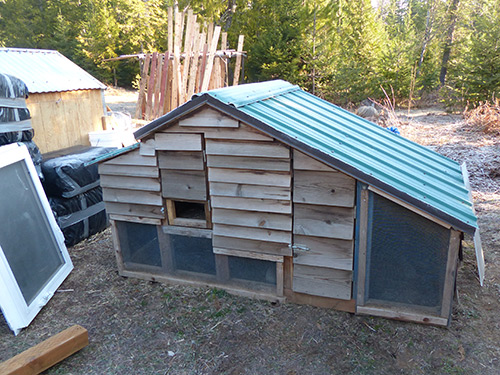
I've experimented with three different coops before settling on one that works fairly well for me and my chickens and it's still not the perfect system. Take a look at what time, materials and/or money you have available before you choose a shelter for your backyard chickens. Having resources available also means having adequate space for storing food for your chickens, litter for the coop and more. If you are building a coop build that into your design from the start.
- Food and Water - One of the number one priorities in learning how to raise chickens is that they need to be able to access food and water easily. Whether that be you giving it to them or having it around for them to graze on, they still need good accessibility to that which gives them energy and life!
Nesting - Although chickens like to be out and about, when it comes to nesting they like some privacy. It's really an intimate act to lay an egg. Chickens are fine with sharing nest areas but it's nice to have enough nests so eggs don't get broken from lots of chickens coming in and out of the nest from their time laying. That said, have at least one nest for every 3 - 4 hens in your flock. Nests for full grown chickens should be at least 20 inches off the ground with a ridge at the edge so the eggs don't roll out of the nest. Knowing that different breeds of chickens may like different amounts of space for their nests, each nest box generally needs to be a minimum of 12 inches wide, 12 inches deep and 12 inches high. Make an angle to the top of the nest boxes so that chickens don't roost on top of them.
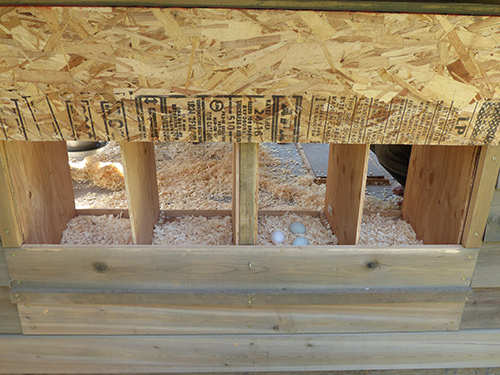
Also, ask yourself how easy you want it to be to gather eggs. For example, I can gather eggs from the inside of my coop as well as from the outside by just simply lifting a door built specifically for accessing eggs.
- Roosting - Chickens like to perch up off the ground. This is called roosting. If your chickens are left outside they could just roost in a tree however there are some chickens that are too hefty to fly up into high branches. No matter what kind of shelter you choose when you start learning how to raise chickens, plan on giving your chickens a roost area that is strong and sturdy enough to hold them up, has a smooth surface so they don't get splinters in their feet but not so smooth that they can't grip it. Each chicken needs 8 - 10 inches of space for roosting between them and roosts should be 2 feet or more above ground. If you have more than one roost (ex. branch) then make them at least 2 feet or more apart from each other.
- Hygiene - Chickens need a clean environment. Ask yourself how often do you want to clean the coop or the area they inhabit? For example, chickens don't thrive well in wet environments for many reasons and they can often get wet when they drink. Wetness can create unclean and unhealthy conditions for them which can lead to illness and diseases. Make sure your chicken coop is waterproof and can withstand rain and snow. As well, often chickens can be untidy no matter how much you work to create sanitary conditions for them. Thus, remember that maintaining a healthy environment for them is essential. Chickens also have a need to be clean just like we do. The irony is that their innate comfort is to do this in dust, sand or dirt. You can find them making a bath by kicking up dust or debris against their bodies. This helps them remove external parasites from their skin. Depending on the living conditions you create for them, you can set out a small trough or large container and fill it with sand for them to have a bath in.
- Purpose for having them - When I first really started learning how to raise chickens, it was eggs I was excited about. I found real pleasure in watching my children discover a new fresh egg in the nest. As I have grown with learning how to raise chickens my priorities have grown, too. I have chickens because I just love having them around, they offer valuable friendship and learning to my children, they fertilize my plants and garden beds, I share eggs with friends and trade them for other resources, I've raised them for meat and taught other people the skill of butchering. Often the purpose you start out with isn't always the one you end up with. Remember it's a journey and that you will indeed grow with your chickens.
- Leave of Absence - It's easy to forget that once you been raising chickens for a while, they simply aren't going on that vacation with you for a week as much as you'd like them to. Thus, it's important to remember that they have needs that go on after you are away. This could look like having a neighbor or friends take care of them in exchange for eggs or having a house sitter over while you're gone. Remember to be mindful of what is realistic for others as you consider your leave of absence. How long does it take to care for them and will you need to walk someone through the process of caring for them before you leave? Envision the process of your leaving and what it will take for your chickens to be cared for so they'll be excited to see you when you return, but not because their needs weren't properly met. It's also important to measure if the amount of support you have in your life and your community is equal to the amount of times you leave per year. If you're someone who travels extensively throughout the year it might be worth reconsidering if it's doable for you to have chickens unless the responsibilities can be shared well with others.
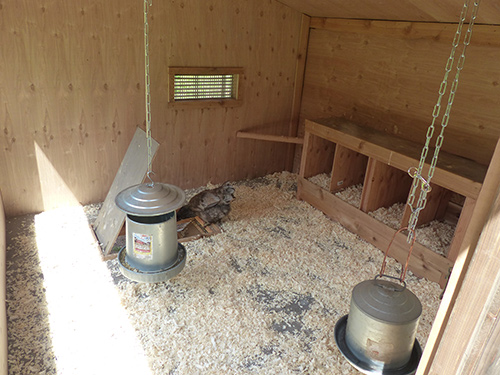
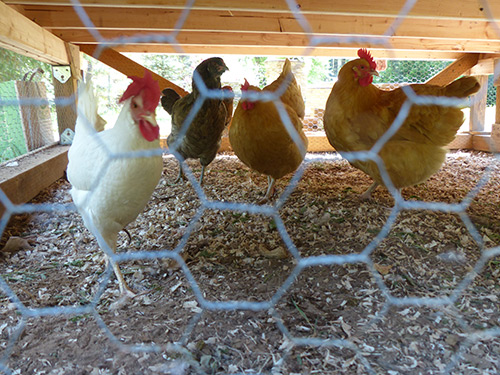
All this said, now ask yourself if you want a coop or open housing for them with a roof? Whether it's in or out, here are some other considerations when choosing, designing and creating a shelter for your chickens.
Water
Water equals life. It is of the utmost importance that your backyard chickens receive fresh, clean water every day. Water needs to be clear and free of germs and scents. There are several different options for how to provide them with the water they need. From troughs, bell waterers, bowls or buckets there are a variety of ways to get creative and figure out what works for you as you learn how to raise chickens. No matter what and how you choose it, remember to include these factors in your watering system:
- Water needs to be clean and the container needs to be easy to clean (free of germs, dirt, etc.)
- The water container needs to be large enough to provide your entire flock of chickens with water for at least one day. If you get a larger container the amount of water might last more than a day depending on the size of your flock and how much they drink.
- The water container should not leak and it should be heavy enough that it won't be knocked over easily by your chickens.
- The water container should be positioned so that the rim is at the same height as the birds' back.
- If you live in a colder climate where water can freeze in the winter get a heated water base or find some other way to keep water from freezing.
Food
If you want to know how to raise chickens you need to understand what comprises their diet. We've just covered water. Let's take a look at their food. They need protein, carbohydrates, vitamins, minerals and fat. Sounds pretty simple right? Well, it is. Just remember that chicks need a diet of high protein and low calcium. When they get to be 12 weeks old they are now juvenile birds and need developer feed that is even lower in calcium and protein than starter feed. By the time they are pullets at 12 months old they should be getting layer feed. They need a balance of fats (like uncultured dairy products and some grains), protein, carbohydrates, vitamins and minerals (like calcium such as oyster shell) and phosphorous (like steamed bone meal).
As adult birds, you can give them food in the form of crumbles, mash, pellets (compressed mash) or scratch (cracked grains), along with some compost and their available seasonal foraging. If you want to ration their food then give them around 1/2 to 1 cup of feed per day and at least 15% protein (of course still taking into account that it might depend on the breed and the season where you live). Remember to give your chickens a diverse diet, and lastly, remember that giving your backyard chickens a healthy dose of greens will heighten the fat in your chickens and their eggs.
For more information, be sure to check out our article, What do Chickens Eat? for a regenrative approach to feeding chickens.
A Simple Primer on Raising Chicks
If in the process of exploring how to raise chickens, you've decided to get baby chicks, you need to have a good set up for them when you bring them to their new home, which will be a brooder box. This can be constructed very simply from a cardboard box that is 2 feet deep and 3 feet wide by 5 feet long. If you can't find something this size you can tape two boxes together. Each chick generally needs 12 inches of square space.
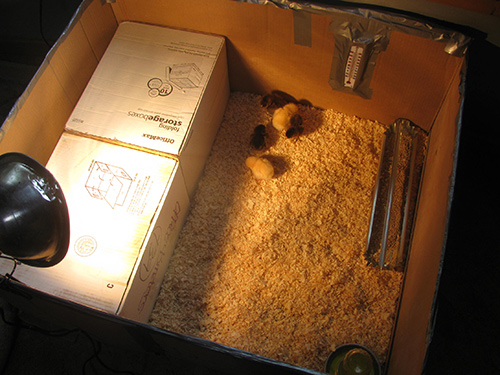
At some point you are going to need to cover the top of the boxes so that as your chicks grow larger they don't fly out of the box. Sprinkle about 2 inches of some fluffy, absorbent pine shavings into the bottom of the box to keep the odor down. Make sure to clean the box at least once a week.
Starting out you need to get a 1 quart waterer. This can be something as simple as a 1 quart glass mason jar screwed onto a metal base found at your local feed store. Keep the water clean and on the cool side of the brooder box so it doesn't drop in mineral content. I've already covered chick starter feed for your chicks. Now all you need is a thermometer to monitor the temperature inside your brooder box and a heat lamp positioned at least 25 inches above the floor. You could opt for a red heat lamp which will keep the chicks from pecking at each other. You want to start the temperature for your chicks at 90 - 95 degrees F and decrease by 5 degrees each week until you reach 70 degrees. Watch for where the chicks hang out in the box. For example, if they hang out under the light a lot it means they are cold and if they are hanging out in the cold side a lot then the temperature is too warm for them. Observe them and let them tell you what they need. If the chicks are hopping around freely and chirping softly then you are well on your way to raising chickens.
Watch for the "pasty butt" phenomenon in your chicks. This is when chick poop gets clumped around their vent area. This occurs for a variety of reasons be it stress from their journey getting to you, eating litter, being chilled or feeling crowded in the brooder box. If this starts happening regularly to one or more of your chicks consider this one of those tracking mysteries where you need to figure out if it's too crowded, if you need to decrease any drafts and make it warmer in the brooder box, or if their food or water is not staying clean. If you find some stuck there get a moist paper towel and gently rub it clean again. This is one of the primary rituals in the journey of learning how to raise chickens.
Last but not least keep your brooder box free from the elements like cold drafts, wet areas, pets or other potential predators, and little children unless you or some other adult is right there to oversee the brooder box. Many a chick has lost its life from a curious pet or child!
Overall health care for your backyard chickens
Just like many people carry around a first aid kit for humans, as you learn how to raise chickens you may find you need a first aid kit in the event that an injury happens. Here are some basic ingredients for a first aid kit you can keep stocked for your chickens:
- Sterile gloves
- Hand towels
- Hydrogen peroxide for washing wounds or lesions
- Cotton balls or gauze pads for cleaning wounds or lesions
- Cornstarch (helps blood to congeal)
- Bandages to prevent bleeding
- Animal antibiotic ointment for torn combs
- Experienced chicken friends and vet phone numbers
Some people give their chickens antibiotics which attack bacteria that can get to their chickens. Others additionally vaccinate their chickens to help combat viruses before they get them. The choice is really up to you. Learning how to raise chickens is similar to learning how to care for the needs of any other pet and needs to be thoughtfully considered and researched before making either of these choices. A first aid kit is very simple and necessary to have around in case your chickens need some basic care when they get injured.
Holding your chickens
At some point in the journey of learning how to raise chickens you'll need to hold your chickens be it to snuggle them, examine them, or even to round them up. It's important to remember that this is a moment you get to bond with your chicken. So slow down and take the time to connect with them.
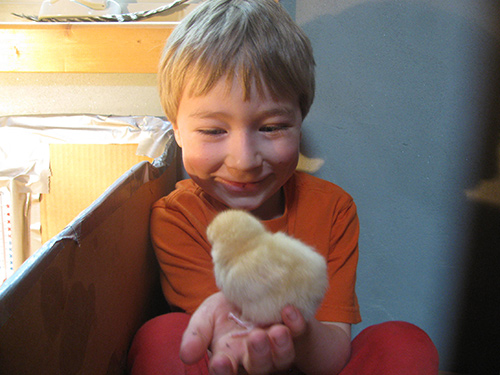
First off you need to get close. You can appeal to them with food, gently corner them or pick them up at night when they are roosting. Some birds will just run away from you while others squat when you approach them and then stick out their wings. Whatever happens, don't chase them around frantically. Relax with them. Once you're near, position yourself to their height. When you pick up the chicken hold them in the middle of your upper body with their wings held down. This prevents them from getting flustered and flapping about. Now that you've got them in a nice hold, pet them and talk with them and take the time to remember they are having an experience, too. Experiencing how to raise chickens can offer you moments of rest in the business of life's activities.
General Management Practices
Regular Routines
Learning how to raise chickens includes regular routines of checking in on your chickens and/or letting them out of the coop at the start of the day. Let this be a ritual that takes you outdoors to get fresh air and greet the day. Make sure they have fresh water and food and refresh if needed. Collect any eggs morning and night. Survey around the coop for signs of predators. Put your chickens back in at the day's end, close down the coop and give thanks for your feathered friends who give you so many gifts of food and friendship.
Make it a practice to clean the coop weekly. Supply it with fresh litter and check for any repairs or future upgrades that might be needed to the coop. Observe your chickens to make sure they look healthy.
Look for the pattern of absence in your routine. For example, there could be a period of time when you are gathering eggs and day after day there aren't any to gather. This might mean that one or more of your chickens has gone broody and stopped laying. You would then want to incorporate a new routine of removing the chicken from the nest for a month or so until she comes out of her broodiness. If it's not about being broody then perhaps it's molting. This means that one or more of your chickens are replacing their feathers with new ones and it will be two months until they start laying again. When you first learn how to raise chickens you can put a wooden egg in each nesting box. They may be quicker to lay eggs from the power of suggestion.
Depending on your set up, rotate your chickens so they get new surface area on the land for dust baths, exercise, variety, change and foraging for new plants while giving now fertilized soil and grazed plants a rest.
Introducing new birds
As you move through the journey discovering how to raise chickens, remember that chickens can live well up to 7 years but their robust egg laying time is only optimal in the first two years of their life. You might want to consider adding new birds to your flock when they start to get older. Plus older birds serve as mentors to younger birds by teaching them where to find food, lay eggs or find themselves in the pecking order.
If you ever plan on expanding your flock remember it's a sensitive moment to introduce new housemates. See if you can create or build in from the beginning a hiding area for the new birds to seek respite. It can often be stressful for a new bird to find their way in the pecking order. While it can be a bit more challenging, if you can create a separate cage or living area where the flock can observe each other for several weeks before they start living together this helps support better integration. You could also try introducing new birds at night when chickens are overall more docile and relaxed.
Connecting to the Cycle of Life
When we learn how to raise chickens we gain the greater lessons of what processes and cycles are all about. We gain the connection to where our food comes from and experience gathering food as a much more intimate experience. We receive food when it's fresh and gain a greater sense of what relationship really means in our lives. This can be a transformative experience, particularly in contrast to a long pattern of buying food from the store.
Thankfully more food is being sold locally these days, yet I can't think of anything more local than gathering eggs from chickens you've raised yourself in your backyard. It's incredibly meaningful and gratifying to raise baby chicks with love and care, bond with them daily and watch them grow into mature birds who then give food to my family and me every day. It's this kind of deeper connection that we as humans are wired for and yearn for in order to be truly happy and have a life worth living.
Additional Resources
There are an abundance of chicken books and magazines you can read on learning how to raise chickens. For some people it can be overwhelming to know which books are worthy of their time when just getting started. Here are a couple of books that will further support your journey now that you've been introduced to raising chickens:
- Storey's Guide to Raising Chickens by Gail Damerow
- Free-Range Chicken Gardens: How to Create a Beautiful, Chicken-Friendly Yard by Jessi Bloom
Interested in being personally mentored in Permaculture & Regenerative Design, on a transformational journey of connection to nature, community, and self?
Check out the Twin Eagles Wilderness Immersion Program.
comments powered by Disqus
Return from How to Raise Chickens to Permaculture Gardening
Return from How to Raise Chickens to Wilderness Survival (homepage)
Track Us